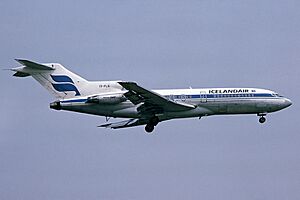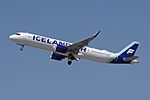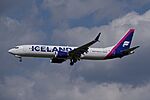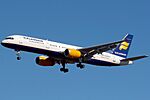Icelandair facts for kids
 |
|
| Founded | 3 June 1937 |
|---|---|
| AOC # | IS-001 |
| Hubs | Keflavík International Airport |
| Focus cities | Reykjavík Airport |
| Frequent-flyer program | Saga Club |
| Fleet size | 42 |
| Destinations | 60 |
| Parent company | Icelandair Group |
| Headquarters | Hafnarfjörður, Iceland |
| Key people | Bogi Nils Bogason (CEO) |
| Revenue | |
| Net income | |
| Employees | 3,638 (2023) |
Icelandair is the main airline of Iceland. It is like the country's official airline, also known as its flag carrier. Icelandair is part of the Icelandair Group and flies to many places across the Atlantic Ocean. Its main base, called a hub, is at Keflavík International Airport. There is also a smaller hub at Reykjavík Airport for flights only within Iceland.
Iceland's location is perfect for flights that cross the Atlantic. Passengers can stop over in Iceland on their way between North America and Europe. This "Atlantic Bridge" route is a big part of the airline's plan. Icelandair also focuses on flights to, from, and within Iceland. The airline's main office is in Hafnarfjörður.
Contents
How Icelandair Started
Early Years as Flugfélag Íslands
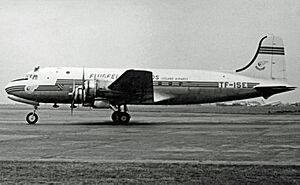
Icelandair's story began in 1937. It started as Flugfélag Akureyrar in Akureyri, a town on Iceland's north coast. Flights began in 1938 with one Waco YKS-7 plane that could land on water. In 1939, the airline stopped flying when this plane was damaged.
In March 1940, the airline moved its main base to Reykjavík. It started flying regular routes with planes that landed on water, called seaplanes. The company also changed its name to Flugfélag Íslands, which means Flight Company of Iceland. For international flights, it used the name Iceland Airways.
During World War II, the British Army built Reykjavík Airport south of the capital. In 1946, the airport was given to Icelandic authorities. Iceland Airways (now Icelandair) used a small building there. This building has grown over the years and is still used by Icelandair for domestic flights today. By the 1950s, Iceland Airways flew to Britain and Northern Europe, as well as within Iceland.
The airline grew its fleet of planes. In 1944, it got a Consolidated PBY Catalina. This was the first plane registered in Iceland to be flown there by an Icelandic crew from North America. On July 11, 1945, this plane made the airline's first commercial flight across the Atlantic Ocean. It flew from Reykjavík to Largs in Scotland.
In 1946, regular flights to Scotland and Denmark began. The airline also started using the Douglas DC-3 for domestic flights, making them more comfortable. Six of these planes were bought and used until 1972. Until the late 1960s, Flugfélag mostly focused on flights within Iceland. However, it also continued international flights. In 1948, the Douglas DC-4 was added for international routes. In 1957, two new Vickers 759 Viscounts were bought. These were the first turboprop planes used by an Icelandic airline. In the 1950s, Flugfélag started using the name Icelandair for its flights outside Iceland.
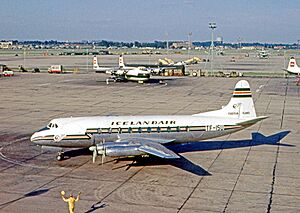
In 1967, Flugfélag was the first Icelandic airline to use jet planes. A Boeing 727-100 called Gullfaxi began service. This jet plane was too big for Reykjavík Airport, so it flew from Keflavík Airport. Most of Flugfélag's international flights moved to Keflavík around this time. Only shorter flights to Greenland and the Faroes remained at Reykjavík Airport. Another 727 was bought in 1971, and these planes were used until 1990.
Loftleiðir: The "Hippie Airline"
Another airline, Loftleiðir, was started in 1944 by three young pilots. Its name means "Skyways." This company first flew within Iceland using small planes.
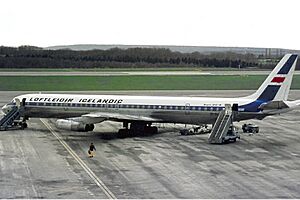
Loftleiðir began flying international routes in 1947. Soon, it started competing with Flugfélag for flights within Iceland. By 1952, the Icelandic government worried that the competition would harm both airlines. They tried to make them merge. When that didn't work, the government divided the domestic routes between the two airlines. This led Loftleiðir to stop domestic flights and focus on international ones.
Loftleiðir started offering low-cost flights across the North Atlantic in 1953. It was one of the first airlines to offer cheaper flights, even before low-cost carriers became common in the 1970s. Loftleiðir was not part of the usual airline agreements that set ticket prices.
In the late 1960s, Loftleiðir grew. In 1964, it got Canadair CL-44 planes, which were the largest planes flying across the Atlantic at the time. Because of these big planes, Loftleiðir moved all its operations to Keflavík Airport that same year. It completely left Reykjavík Airport. The building Loftleiðir had planned as a passenger terminal at Reykjavík Airport later became a hotel and Loftleiðir's main office. This building was Icelandair's headquarters until 2024.
In 1969, Loftleiðir bought International Air Bahama, a small airline that flew between Nassau and Luxembourg. A year later, Loftleiðir helped start Cargolux, a cargo airline. Also in 1970, Loftleiðir started using jet planes with its first two DC-8 aircraft.
During these years, many people called Loftleiðir "the Hippie Airline" or "the Hippie Express." The airline was known for its low prices, not for being super fast or always on time. Flying with Loftleiðir became a common experience for young people traveling between America and Europe. Even future U.S. president Bill Clinton flew with them.
Icelandair is Born: The Merger
During the 1970s energy crisis, both Flugfélag Íslands and Loftleiðir faced financial problems. The Icelandic government tried again to merge the two airlines. This time, in 1973, after long talks, they succeeded. A new company called Flugleiðir was created. It brought the two airlines together and started to combine their staff and operations.
In 1979, Flugfélag Íslands and Loftleiðir officially became one airline, Flugleiðir. The airline was then renamed Icelandair.
Icelandair After the Merger
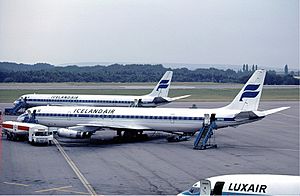
In the 1990s, the Boeing 757-200 became the main plane for Icelandair's transatlantic flights. Smaller planes were replaced for domestic and European routes. Icelandair's business grew, and by 1997, over one million passengers flew with the company. It was known as a "backpacker airline," similar to how Loftleiðir was called the "Hippie Airline."
In 1997, Icelandair's domestic flights were combined with a smaller airline to form Air Iceland. This allowed the main Icelandair company to focus completely on international flights. In 1999, Icelandair introduced a new look for its planes. This was part of a plan to change its image from a "backpacker" airline to one that also focused on business travel. In 2001, the Icelandair hub officially moved to Keflavík International Airport.
The company faced challenges, including the September 11 attacks in 2001, which affected air travel. Between 2002 and 2005, the Flugleiðir company was reorganized into Icelandair Group (for aviation) and FL Group (for other investments). Icelandair became the largest part of the Icelandair Group.
Recent Developments
Icelandair was affected by the financial crisis in Iceland in 2008. It was also impacted by a volcanic eruption in 2010. The ash cloud from the volcano closed much of Europe's airspace. Icelandair worked hard to keep flights going, even moving its headquarters to Glasgow, Scotland, for ten days. From there, they flew shuttle flights to Iceland's Akureyri Airport and arranged buses to Reykjavík.
After the eruption, the Icelandic government started the "Inspired by Iceland" campaign to encourage people to visit Iceland again. Icelandair was a big part of this effort. When the Grímsvötn volcano erupted in 2011, Icelandair was better prepared for airspace closures.
In 2011, Icelandair was named "The Knowledge Company" of the year in Iceland. Its CEO, Birkir Hólm Guðnason, was named "Man of the Year" in the Icelandic business community. Later that year, the airline was also named "Marketing Firm of the Year in Iceland."
In 2024, Icelandair moved its headquarters to Hafnarfjörður. This brought all its offices together in one place. The previous headquarters at Reykjavík Airport had been used for over 50 years.
Expanding Routes
Icelandair continued to add new destinations. After starting flights to Washington, D.C., in 2011, it added Denver in 2012 and Anchorage in 2013. This brought the total number of U.S. cities served to eight. In 2012, Icelandair also started flights linking Akureyri to its Keflavík hub through its subsidiary, Air Iceland.
From 2009 to 2014, the airline's operations doubled. New flights to Vancouver, Edmonton, and Geneva were added in 2014.
On December 9, 2014, Icelandair showed off a special Boeing 757-200 plane (TF-FIU) called Hekla Aurora. It had artwork of an Icelandic winter scene and special lights inside that looked like the Aurora Borealis (Northern Lights).
In 2015, Birmingham became Icelandair's fifth destination in the UK. Flights to Portland, Oregon, also started. Further expansion was announced with new flights from Chicago O’Hare International Airport in 2016. Icelandair also added a new service between Keflavik and Aberdeen, Scotland, operated by Air Iceland Connect.
In 2016, Icelandair began scheduled flights to Paris Orly Airport and Montréal–Trudeau Airport. In September 2016, services to Philadelphia and Tampa in the U.S. were announced for 2017.
In May 2017, Icelandair revealed another special plane, a Boeing 757-200 (TF-FIR) named Vatnajökull. This plane's design honored Europe's largest glacier and celebrated Icelandair's 80th anniversary. In August 2017, Icelandair announced flights to Cleveland, U.S., which began in May 2018.
Since the 1960s, Icelandair has offered passengers flying between North America and Europe a chance to stopover in Iceland for up to seven days at no extra cost.
In January 2018, Icelandair announced three non-stop flights a week from Kansas City International Airport to Keflavík. These began in May 2018. Four weekly flights to Dallas Ft. Worth started in May 2018.
On November 5, 2018, Icelandair planned to take over another Icelandic airline, WOW Air. However, on November 29, Icelandair decided not to go through with the plan.
In September 2020, Icelandair raised more money by selling new shares. The Icelandic government also provided a loan guarantee of $120 million.
On March 16, 2021, domestic flights operated by Air Iceland Connect (a part of Icelandair Group) began flying under the Icelandair name.
Icelandair announced a new route to Istanbul, starting in September 2025. In January 2025, it was reported that Icelandair would start non-stop flights between Reykjavik and Miami in January 2026. These flights will use its Airbus A321LR planes.
What It's Like to Fly with Icelandair
Cabins and Entertainment
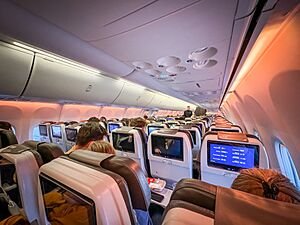
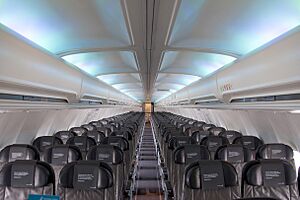
Icelandair has three types of tickets: Economy Light, Economy, and Saga Class. Saga Class is similar to Business class, but the seats do not lie completely flat. Only Saga Class passengers get free meals. Economy passengers can buy food and drinks on board.
All Icelandair planes have a free video entertainment system. Each passenger has a screen with movies and shows. In 2013, the Icelandic band Sigur Rós released their album Valtari only on Icelandair flights two months before it was available to everyone. Björk's 2011 album, Biophilia, was also released this way. All Icelandair planes have Wi-Fi, except for the smaller Dash 8 planes used for short flights.
Saga Club: Frequent Flyer Program
Icelandair's frequent-flyer program is called Saga Club. Members can earn points when they fly with Icelandair or its partner airlines. These points can be used for future travel or for purchases from the Saga Shop on board. As of January 2021, Alaska Airlines and JetBlue are the only partner airlines where you can earn Saga points. Alaska Airlines is the only partner where you can use points for travel.
In-flight Magazine
Icelandair Info is the airline's magazine. It comes out four times a year in Icelandic and English. It also works as a catalog for the Saga Shop.
Where Icelandair Flies
Icelandair flies between Iceland and many cities in Europe and North America. Some of these flights are only available during certain seasons.
Partner Airlines
Icelandair works with other airlines through codeshare agreements. This means you can book a flight with Icelandair, but part of your journey might be on a partner airline's plane.
- Air Greenland
- airBaltic
- Air India
- Alaska Airlines
- Atlantic Airways
- Emirates
- Finnair
- ITA Airways
- JetBlue
- Scandinavian Airlines
- TAP Air Portugal
- Turkish Airlines
Icelandair also has interline agreements with over 70 airlines. This allows passengers to easily connect between flights on different airlines. Some of these include:
- Hahn Air
- Porter Airlines
- Southwest Airlines
- Sun Country Airlines
- Swiss International Air Lines
- WestJet
Icelandair's Fleet
Current Aircraft
As of May 2025, Icelandair uses the following planes. Many of them are named after Icelandic volcanoes.
| Aircraft | In service | Orders | Passengers | Notes | ||
|---|---|---|---|---|---|---|
| J | Y | Total | ||||
| Airbus A321LR | 4 | — | 22 | 165 | 187 | Deliveries began in 2024. These planes are replacing older Boeing 757-200 and Boeing 767-300ER aircraft. |
| Airbus A321XLR | — | 13 | TBA | Icelandair has options for 12 more. Deliveries will start in 2029. These will also replace Boeing 757-200 and Boeing 767-300ER planes. |
||
| Boeing 737 MAX 8 | 17 | — | 16 | 144 | 160 | |
| Boeing 737 MAX 9 | 4 | — | 16 | 162 | 178 | |
| Boeing 757-200 | 11 | — | 22 | 161 | 183 | These planes will be retired by 2026. They are being replaced by Airbus A321LR and Airbus A321XLR. |
| 20 | 164 | 184 | ||||
| Boeing 767-300ER | 3 | — | 25 | 237 | 262 | These planes will be retired by 2029. They are being replaced by Airbus A321LR and Airbus A321XLR. |
| De Havilland Canada Dash 8-200 | 3 | — | — | 37 | 37 | These planes came from Air Iceland Connect. They will be retired in 2026. |
| De Havilland Canada Dash 8-400 | 3 | — | — | 76 | 76 | These planes came from Air Iceland Connect. |
| Total | 47 | 13 | ||||
in older livery
Fleet Changes Over Time
In 2005, Icelandair ordered ten Boeing 737-800 planes. These were leased to other airlines. They also ordered two Boeing 787 Dreamliners, and two more in 2006. However, in 2011, orders for three of the 787s were canceled.
On February 13, 2013, Icelandair ordered 16 new Boeing 737 MAX planes. They also had the option to buy eight more. These planes were delivered between 2018 and 2021. The order included nine 737 MAX 8s and seven 737 MAX 9s.
In May 2019, Icelandair considered buying Airbus A321neo and Airbus A321LR planes. This was to replace their older Boeing 757s or to fly alongside their Boeing 737 MAX 8s.
In August 2020, Icelandair reached an agreement with Boeing about the MAX planes that had been grounded. This agreement reduced the number of future MAX planes Icelandair would buy by four.
On April 7, 2023, Icelandair announced plans to order up to 25 A321XLRs. They also planned to lease four A321LRs. These Airbus planes will replace the aging Boeing 757 fleet. This was the first time Icelandair ordered Airbus planes. The first Airbus A321LR was delivered on December 2, 2024.
In December 2024, Icelandair's two Boeing 757-300 planes were leased to Fly Khiva in Uzbekistan. On April 29, 2025, Icelandair announced that their Boeing 767-300ER planes would be retired by autumn 2029.
Special Plane Designs
As of November 2024, Icelandair has two planes with special designs, called liveries. These designs show off Iceland's beautiful nature. One plane features Vatnajökull, Europe's largest glacier. It also celebrates 100 years of Iceland's independence. The other plane highlights the Aurora Borealis (Northern Lights).
A third plane (Boeing B757-300 TF-ISX "Þingvellir") was painted with the colors of Iceland's flag. It celebrated 100 years of Icelandic independence (1918–2018) and the men's national football team's first World Cup appearance in 2018. This plane was retired from the Icelandair fleet in October 2024.
| Registration | Livery | Aircraft | Refs |
|---|---|---|---|
| TF-FIU | Hekla Aurora | Boeing 757-200 | |
| TF-FIR | Vatnajökull | Boeing 757-200 | |
| TF-ISX | 100 years of Independence | Boeing 757-300 |
Historical Fleet
Over the years, Icelandair has used many different types of aircraft.
| Aircraft | Total | Introduced | Retired | Notes |
|---|---|---|---|---|
| Airbus A319-100 | 1 | 2019 | 2019 | Leased for a short time |
| Boeing 727-100C | 3 | 1967 | 1989 | Originally from Flugfélag Íslands |
| Boeing 727-200 | 2 | 1980 | 1990 | |
| Boeing 737-300 | 3 | 1991 | 2004 | |
| Boeing 737-400 | 5 | 1989 | 2001 | |
| Boeing 747-100 | 1 | 1982 | 1984 | Leased for short periods |
| Boeing 757-300 | 2 | 2002 | 2025 | Sold to Fly Khiva in April 2025 |
| Canadair CL-44 | 5 | 1964 | 1979 | From Loftleiðir |
| Consolidated PBY Catalina | 5 | 1944 | 1960 | Originally from Flugfélag Íslands |
| De Havilland Dragon Rapide | 2 | 1945 | 1955 | Originally from Flugfélag Íslands |
| Douglas C-47 Skytrain | 10 | 1946 | 1970 | Originally from Flugfélag Íslands |
| Douglas C-54 Skymaster | 11 | 1947 | 1967 | Originally from Flugfélag Íslands |
| Douglas DC-6B | 7 | 1959 | 1975 | |
| Douglas DC-8-63 | 15 | 1981 | 1990 | From Loftleiðir |
| Fokker F27 Friendship | 14 | 1965 | 1992 | Used for domestic, Faroe, and Greenland flights |
| Fokker 50 | 4 | 1992 | 2015 | Used for domestic, Faroe, and Greenland flights |
| Vickers Viscount 700D | 2 | 1957 | 1970 | Originally from Flugfélag Íslands |
Icelandair Cargo
About Icelandair Cargo
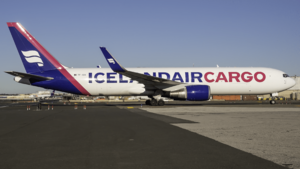
Icelandair Cargo is a separate company within the Icelandair Group. It handles cargo (freight) transportation. Both Flugfélag Íslands and Loftleiðir carried cargo on their planes. When Icelandair was formed in 1973, it created a special division for freight.
In 2000, Icelandair Cargo became its own company. It uses space in the baggage areas of Icelandair's passenger planes. It also operates two Boeing 757 cargo planes. These fly to destinations in Europe and North America from Keflavík International Airport.
In 2021, Icelandair Cargo announced that some Boeing 767-300ER passenger planes would be changed into cargo planes. The first converted 767-300BCF was delivered in December 2022. This increased capacity helps Icelandair Cargo open new routes to the United States.
In May 2025, Icelandair Cargo signed an agreement with My Freighter Airlines from Uzbekistan. This will help transport cargo between Central Asia, Europe, and North America.
Cargo Fleet
As of April 2024, the Icelandair Cargo fleet has the following planes:
| Aircraft | In service | Orders | Notes |
|---|---|---|---|
| Boeing 767-300BCF | 2 | — | |
| Total | 2 | — |
Sponsorships
Icelandair and the City of Reykjavík are major sponsors of the Iceland Airwaves. This is an annual music festival held in Reykjavík every November.
Accidents and Incidents
Aviation accidents are very rare, but they are important to learn from. Here are some past incidents involving Icelandair and its earlier companies:
- May 29, 1947: A Flugfélag Íslands plane crashed near Héðinsfjörður. All 21 passengers and four crew members died. This is the worst aviation accident in Iceland's history.
- March 7, 1948: An Avro Anson plane belonging to Loftleiðir crashed on a mountain called Skálafell. The pilot and five passengers died.
- January 31, 1951: A DC-3 plane, named Glitfaxi, crashed into the sea near Hafnarfjörður. All 17 passengers and three crew members died. This happened during heavy snow as the pilots tried to land at Reykjavík Airport.
- April 14, 1963: A Vickers Viscount plane crashed while approaching Oslo-Fornebu Airport. All 12 people on board died.
- September 26, 1970: A Flugfélag Fokker F27 Friendship plane crashed into a mountain near Vágar, Faroe Islands. This happened while it was approaching Vágar Airport. Seven passengers and one crew member died out of 34 people on board.
- November 15, 1978: Loftleiðir Flight 001, a Douglas DC-8, crashed near Colombo Airport in Sri Lanka. It was a chartered flight. 181 passengers died, while 74 passengers and 5 crew members survived.
- January 22, 2002: Icelandair Flight 315, a Boeing 757-200, experienced extreme movements during a landing attempt at Oslo Airport, Gardermoen. The plane went through forces higher than its design limits. Control was regained, and the plane landed safely on a second attempt.
- February 7, 2020: Icelandair Flight 529, a Boeing 757-200, had its right landing gear collapse after landing at Keflavík International Airport. There were no injuries among the 166 people on board.
See also
 In Spanish: Icelandair para niños
In Spanish: Icelandair para niños


